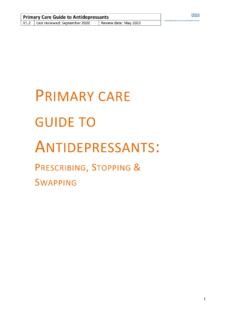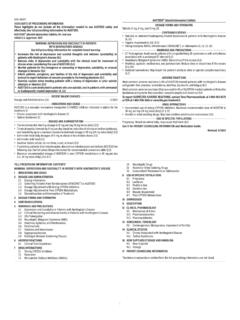Transcription of Postural Hypotension What it is & How to Manage it
1 Postural Hypotension or orthostatic Hypotension is when your blood pressure drops when you go from lying down to sitting up, or from sitting to standing. When your blood pressure drops, less blood can go to your organs and muscles. This can make you more likely to fall. Centers for Disease Control and Prevention National Center for Injury Prevention and Control For information about fall prevention, visit For more information about Hypotension , visit Stopping Elderly Accidents, Deaths & Injuries2017 Postural Hypotension What it is & How to Manage it What are the symptoms? Although many people with Postural Hypotension have no symptoms, others do. These symptoms can differ from person to person, and may include: Dizziness or lightheadedness Feeling about to faint, passing out, or falling Headaches, blurry or tunnel vision Feeling vague or muddled Feeling pressure across the back of your shoulders or neck Feeling nauseous, or hot and clammy Weakness or fatigue When might symptoms happen?
2 When standing or sitting up suddenly In the morning when blood pressure is naturally lower After a large meal or alcohol During exercise When straining on the toilet When you are ill If you become anxious or panicky What causes Postural Hypotension ? Postural Hypotension can be caused by or linked to: High blood pressure Diabetes, heart failure, atherosclerosis, or hardening of the arteries Taking some diuretics, antidepressants, or medicines to lower blood pressure Neurological conditions like Parkinson s disease and some types of dementia Dehydration Vitamin B12 deficiency or anemia Alcoholism Prolonged bed rest What can I do to Manage my Postural Hypotension ? Tell your healthcare provider about any symptoms. Ask if any of your medicines should be reduced or stopped. Get out of bed slowly. First sit up, sit on the side of the bed, then stand up. Take your time when changing position, such as when getting up from a chair.
3 Try to sit down when washing, showering, dressing, or working in the kitchen. Exercise gently before getting up (move your feet up and down and clench and unclench your hands) or after standing (march in place). Make sure you have something to hold on to when you stand up. Do not walk if you feel dizzy. Drink 6-8 glasses of water or low-calorie drinks each day unless you have been told to limit your fluid intake. Avoid taking very hot baths or showers. Try sleeping with extra pillows to raise your head.












